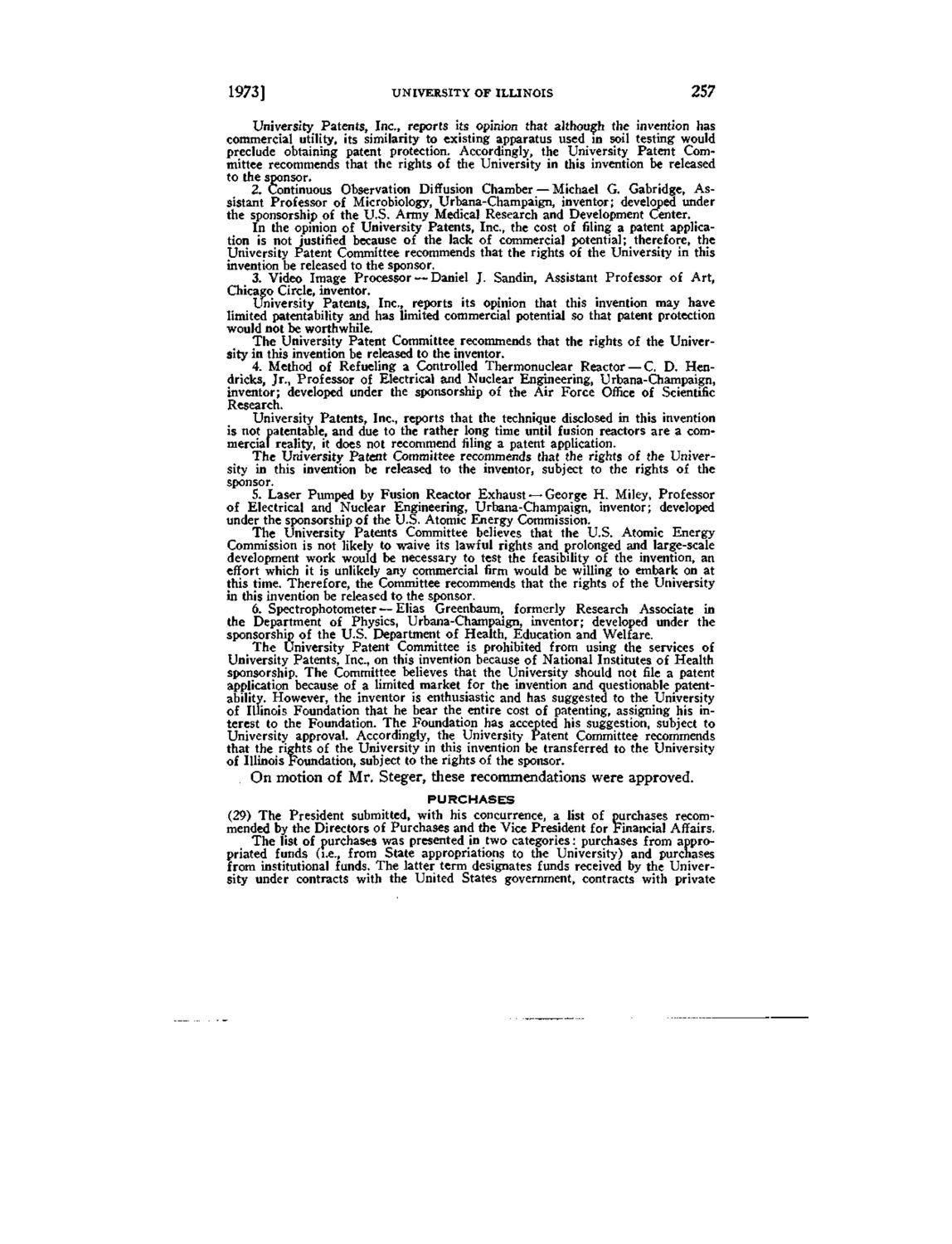| |
| |
Caption: Board of Trustees Minutes - 1974
This is a reduced-resolution page image for fast online browsing.

EXTRACTED TEXT FROM PAGE:
1973] UNIVERSITY OF ILLINOIS 257 University Patents, Inc., reports its opinion that although the invention has commercial utility, its similarity to existing apparatus used in soil testing would preclude obtaining patent protection. Accordingly, the University Patent Committee recommends that the rights of the University in this invention be released to the sponsor. 2. Continuous Observation Diffusion Chamber—Michael G. Gabridge, Assistant Professor of Microbiology, Urbana-Champaign, inventor; developed under the sponsorship of the U.S. Army Medical Research and Development Center. _ In the opinion of University Patents, Inc., the cost of filing a patent application is not Justified because of the lack of commercial potential;_therefore, the University Patent Committee recommends that the rights of the University in this invention be released to the sponsor, 3. Video Image Processor — Daniel J. Sandin, Assistant Professor of Art, Chicago Circle, inventor. University Patents, Inc., reports its opinion that this invention may have limited patentability and has limited commercial potential so that patent protection would not be worthwhile. The University Patent Committee recommends that the rights of the University in this invention be released to the inventor. 4. Method of Refueling a Controlled Thermonuclear Reactor — C. D. Hendricks, Jr., Professor of Electrical and Nuclear Engineering, Urbana-Champaign, inventor; developed under the sponsorship of the Air Force Office of Scientific Research. University Patents, Inc., reports that the technique disclosed in this invention is not patentable, and due to the rather long time until fusion reactors are a commercial reality, it does not recommend filing a patent application. The University Patent Committee recommends that the rights of the University in this invention be released to the inventor, subject to the rights of the sponsor. 5. Laser Pumped by Fusion Reactor Exhaust ~ George H. Miley, Professor of Electrical and Nuclear Engineering, Urbana-Champaign, inventor; developed under the sponsorship of the U.S. Atomic Energy Commission. The University Patents Committee believes that the U.S. Atomic Energy Commission is not likely to waive its lawful rights and prolonged and large-scale development work would be necessary to test the feasibility oi the invention, an effort which it is unlikely any commercial firm would be willing to embark on at this time. Therefore, the Committee recommends that the rights of the University in this invention be released to the sponsor. 6. Spectrophotometer— Elias Greenbaum, formerly Research Associate in the Department of Physics, Urbana-Champaign, inventor; developed under the sponsorship of the U.S. Department of Health, Education and Welfare. The University Patent Committee is prohibited from using the services of University Patents, Inc., on this invention because of National Institutes of Health sponsorship. The Committee believes that the University should not file a patent application because of a limited market for the invention and questionable patentability. However, the inventor is enthusiastic and has suggested to the University of Illinois Foundation that he bear the entire cost of patenting, assigning his interest to the Foundation. The Foundation has accepted his suggestion, subject to University approval. Accordingly, the University Patent Committee recommends that the rights of the University in this invention be transferred to the University of Illinois Foundation, subject to the rights of the sponsor. O n motion of Mr. Steger, these recommendations were approved. PURCHASES (29) The President submitted, with his concurrence, a list of purchases recommended bv the Directors of Purchases and the Vice President for Financial Affairs. The list of purchases was presented in two categories: purchases from appropriated funds (i.e., from State appropriations to the University) and purchases from institutional funds. The latter term designates funds received by the University under contracts with the United States government, contracts with private
| |